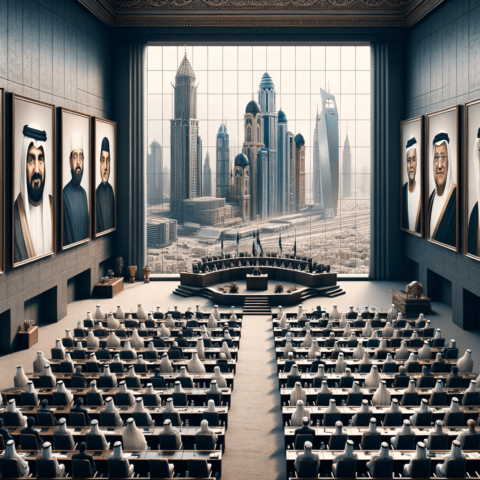
Enhancing Shopping Experiences in Dubai: The New Esaad Card- Carrefour Partnership
May 20, 2024
Connecting Worlds: Elon Musk’s Starlink Lights Up Indonesia
May 20, 2024Following a tragic helicopter crash that resulted in the loss of Iran’s President and key officials, a transitional leadership phase has commenced. This article delves into the political reshuffle and its broader implications for international business and stability, pertinent to global investors and tourists eyeing opportunities in the Middle East.
The Incident and Immediate Aftermath
The Incident and Immediate Aftermath: Detail the helicopter crash involving Iran’s president and other officials. Discuss the impact on the country’s political landscape and immediate international response. Emphasize the sense of urgency and the global attention it garnered, highlighting the robust structures in place for a swift political transition.
A tragic helicopter crash involving Iran’s President and several high-ranking officials has sent shockwaves through the nation and the global community. The catastrophic event, which occurred during an official tour of southern Iran, has left the country grappling with a sudden vacuum in its highest echelons of power. The devastating incident has not only claimed lives but also reignited political tensions and uncertainty within Iran’s political landscape.
The immediate aftermath of the crash bore witness to a frenetic scramble to stabilize the government. Instinctive responses saw Iranian military and emergency services rapidly mobilizing, showcasing the country’s readiness to address crises. This swift action mitigated further chaos and demonstrated the inherent structures designed to ensure swift transitions in leadership.
Internationally, the incident provoked a cascade of reactions, from expressions of condolences to assessments of geopolitical impacts. Global leaders, keenly aware of Iran’s strategic importance, extended their sympathies while simultaneously evaluating the broader implications for regional stability. Diplomatic channels buzzed with urgent communications, reflective of the global emphasis on a stable Iran for continued international relations and business engagements.
This dramatic and sudden shift has underscored the critical nature of established protocols for ensuring continuity in governance. Iran’s ability to navigate this tumultuous period, leveraging its robust political frameworks, will be pivotal in determining both domestic stability and its ongoing role in the international arena.
Transition of Power: A Legal Perspective
The unfortunate helicopter crash that incapacitated Iran’s President and other key officials has sharply diverted global focus onto Iran’s constitutional mechanisms for ensuring continuity of leadership. Under Article 131 of the Iranian Constitution, Vice President Mohammad Mokhber is empowered to step in as Acting President. This framework is designed to prevent any vacuum in executive power, ensuring that governmental function and authority remain undisrupted.
The legal provisions for presidential succession are meticulously outlined to guarantee smooth transitions. Should the President be unable to perform duties due to illness, death, resignation, or in this case, a tragic accident, the first vice president automatically assumes the role with immediate effect. This seamless transfer of power not only reflects foresight embedded within Iran’s constitutional law but also strengthens institutional resilience in times of crisis.
**Historically**, nations with robust succession laws have demonstrated superior stability during unforeseen leadership transitions. For instance, the United States has the Presidential Succession Act, which specifies the line of succession beyond the Vice President, ensuring the continuity of government operations. Similarly, in Russia, should the President be incapable of fulfilling their duties, the Prime Minister assumes the acting role until new elections are held.
These legislative provisions are critical for maintaining public confidence and operational stability. In Iran’s context, the swift assumption of duties by Mohammad Mokhber is a testament to the nation’s preparedness and structured governance. Given the heightened global attention and immediate international responses, such mechanisms reassure both the domestic and international community of Iran’s strategic continuity and political stability during turbulent times.
Economic and Diplomatic Ramifications
The transition of power brings with it a set of complex economic and diplomatic ramifications that could potentially redefine Iran’s role on the global stage. Iran’s economic ties, particularly with countries critical to Middle Eastern tourism and business, might undergo significant shifts. The new leadership’s policy orientation will play a major role in determining whether existing trade agreements are honored or renegotiated. Notably, a more open economic stance might attract international investments, enhancing Iran’s economic footprint and potentially leading to softening of sanctions.
Diplomatic relations could experience a reset, with countries like China, Russia, India, and members of the European Union reconsidering their positions based on the anticipated policy adjustments. The economic corridors could expand, fostering greater interdependence within the region.
For Dubai, a key nexus in Middle Eastern tourism and business, these shifts could be incredibly impactful. Dubai’s economy, deeply intertwined with regional dynamics, might see new opportunities or face fresh challenges depending on Iran’s policies. An open Iran might translate into increased competition for Dubai’s markets, or alternatively, a collaborative expansion of tourism circuits and business networks that could mutually benefit both.
International investors will be keenly monitoring these developments, as any major shifts in Iran-Dubai relations might necessitate reevaluation of portfolios and strategic alliances. Overall, the economic and diplomatic landscape in the Middle East could be poised for reconfiguration, prompting businesses to stay adaptive and vigilant.
Looking Ahead: The Future of Iranian Governance
As Iran gears up for its next presidential election, speculation runs high about the potential outcomes and the ramifications for governance. With the current administration marking its final phase, various political factions vie for influence, each with its own vision for Iran’s future. The rise of reformist candidates or a conservative stronghold can swing the pendulum significantly, impacting not only domestic policies but also international alignments.
The new leadership, regardless of its nature, will need to address a population increasingly vocal about economic stagnation and social liberties. Failure to meet these demands could result in further domestic unrest, influencing governmental policies toward greater openness or tighter control. These shifts will inevitably reverberate through the Middle Eastern political sphere. Regional rivals like Saudi Arabia and allies like Russia and China will closely monitor Iran’s trajectory. How Iran’s new leadership navigates relations with global powers, including the U.S., could redefine strategic alliances and power balances across the region.
Foreign investors and tourists eyeing Iran must stay attuned to these political currents. Businesses may see new opportunities if reformists come to power and ease regulatory hurdles and sanctions. Conversely, a conservative win could complicate trade further but might also lead to regional agreements benefiting some sectors. For tourists, changes in visa regulations, security measures, and cultural attitudes could directly affect travel plans. Understanding these potential outcomes will be crucial for stakeholders looking to align their strategies with Iran’s evolving political landscape.
Conclusions
Iran’s political landscape is undergoing a significant transformation with potential global repercussions. For Dubai’s tourists and business community, understanding these changes can offer strategic insights into emerging opportunities and risks in the Middle East, fostering informed decision-making in travel and investment.





